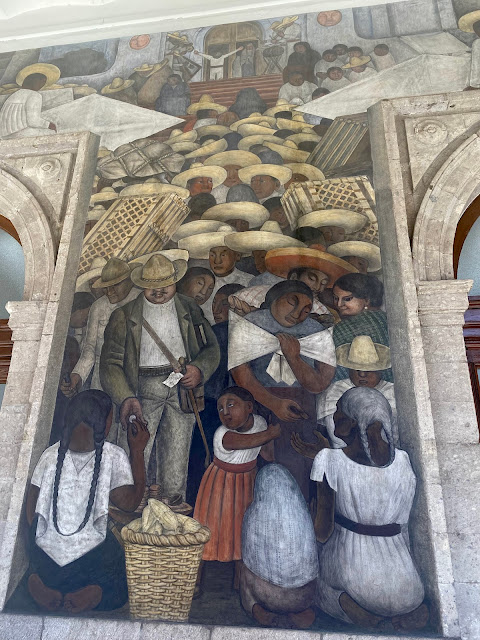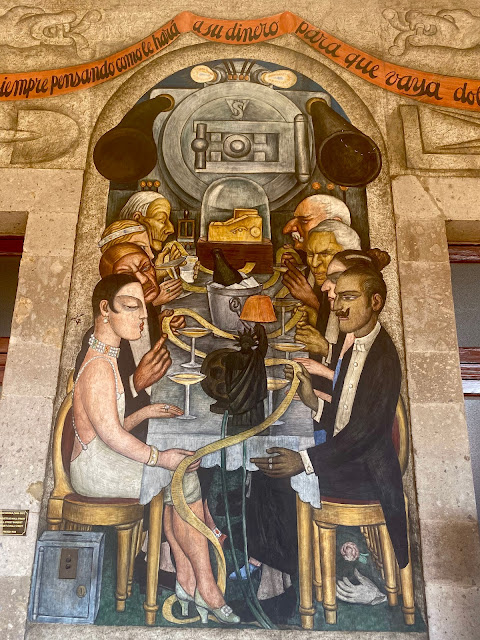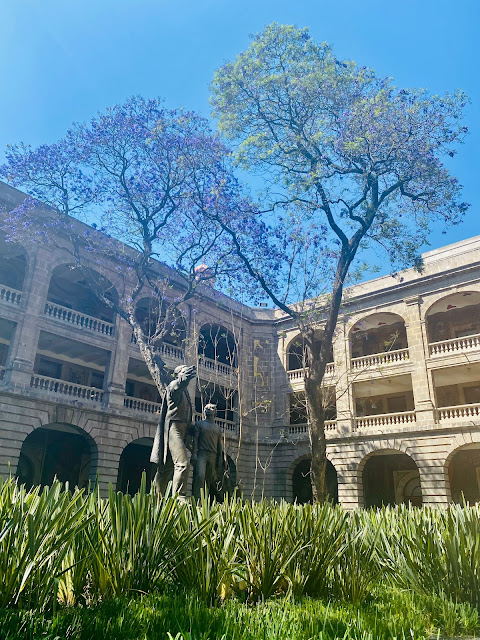If you want to be astonished by one great artist's creative output, get your ass to the Secretaria de Educacion Publica, a nondescript government building in Mexico City and take a gander at the 120 frescoes Diego Rivera painted on the four walls of an interior courtyard, mostly in the early 1920s.
 |
| "Tehuantepec Women" (1923) |
 |
| "The Rural Teacher" (1923) |
 |
| "The Deer Dance" (Detail, 1923) |
The world order recently had been shaken up by both the Mexican (1910) and Russian (1917) revolutions. Rivera clearly sympathized with the workers.
That's not to suggest he and Frida, his second wife, were revolutionaries despite his militant depiction of her (center, orange) beneath the hammer and sickle. He accepted commissions from Edsel Ford and John D. Rockefeller, both uber Capitalists in the early 30s.
But I'm guessing that Rivera would have ascended to a higher rank in the canon of Western Civilization if his work on the upper floor wasn't so unsparing in its depiction of greedy individuals who profit from the labor of others. It's almost cartoonish.
 |
| "In The Arsenal" (1929) |
Until it's not. Here's the post-revolutionary fate Rivera imagines for the One Percent in his homeland.
 |
| "Death of the Capitalist" (1928) |
The jacaranda trees were almost in full bloom during our visit. Benito Juárez, the first indigenous president of Mexico and the man responsible for separating the church from the state in the Mexican constitution, gestures from beneath.
Here's how Diego Rivera painted him in "Dream of a Sunday Afternoon in Alameda Park," an enormous mural housed in a separate museum. He's at the top, holding a copy of Mexico's constitution.
Bas reliefs, set off by gold-colored brick, decorate the intersection of the walls on the upper floors.
You'll also find the symbol of Mexico on the third floor, along with the seals of many of Mexico's 31 states. Rivera's students helped him paint these.
I'm ashamed to admit I didn't know the name of the state that's home to Ciudad Juárez, just across the border from where I grew up in El Paso.
I recognized Quintana Roo because that's what Joan Didion and John Gregory Dunn called their only child. Was Joan ever off trend?
Rivera didn't create all the art work adorning the Secretaria de Educacion Publica. You almost can feel the exertions of these clearly Mesoamerican men.
 |
| "The Bearers" by Jean Charlot (1923-24) |















No comments:
Post a Comment